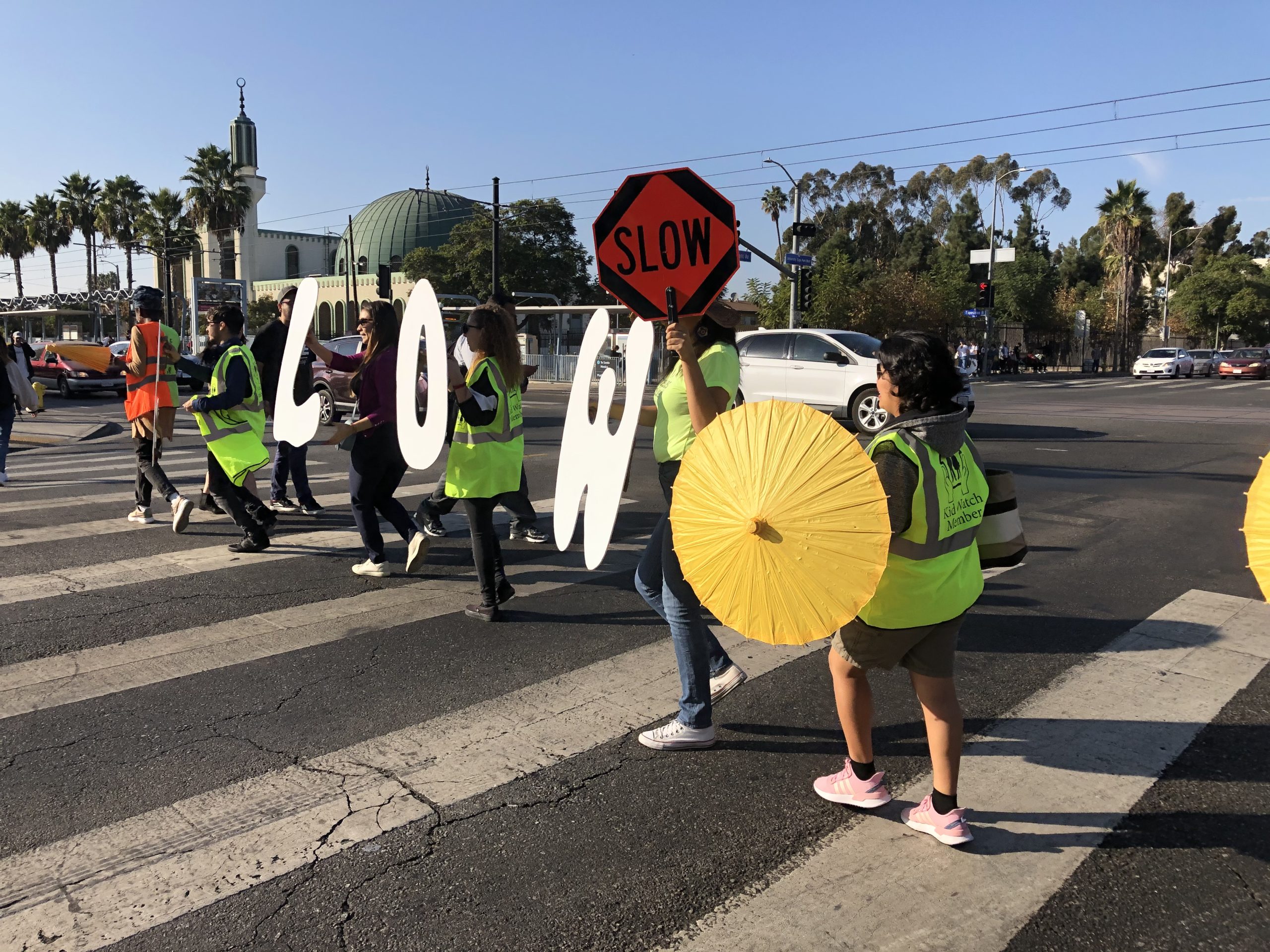BY Chandrea Miller
The streets around USC are among L.A.’s most deadly for pedestrians including students, parents and schoolchildren. In fact, according to the City of Los Angeles High Injury Network (HIN), that spotlights and collects data on streets with a high concentration of severe injuries and deaths–six of those intersections are just outside USC’s University Park Campus.
The University Park Slow Jams project – made up of a coalition of USC Arts in Action, USC Price School, USC Kid Watch, Los Angeles Walks and Public Matters – strives to draw attention to the traffic violence problem and generate solutions through policy, community building and artistic expression.
Arts in Action lead producer William Warrener said the call to action cannot be ignored when it is so close to campus.
“Our campus is really a privileged place to be for how safe people feel particularly from cars,” Warrener said. “It is not like the surrounding area.”
An area already dangerous to pedestrians has become more so due to the pandemic stay-at-home orders.
“People are driving with abandon,” Warrener said.
Numbers released from the City of Los Angeles report that in 2019, roughly 11 Los Angeles pedestrians were killed per month—that’s 128 total deaths. In May 2020 alone, 21 pedestrians were killed. The Los Angeles Police Department says the number of pedestrian deaths has increased 69 percent over the past five years.
David Sloane, professor of Urban Planning at USC Price, said he hopes to drastically decrease those numbers by inspiring change in the community, by the community.
“You don’t just send out information to the community–you have to create and develop an effective educational program,” Sloane said. “And that’s where art can play an integral role; artists are amazingly capable in raising policy and planning issues in ways that most people aren’t.”
That’s where the Arts in Action University Park Slow Jams Project comes in.
The project, scheduled to take place in late 2020, will use arts interventions and neighborhood capacity building to improve pedestrian safety on the streets around USC for the entire neighborhood, including schoolchildren and students.
Professor Sloane said that he recently held a Slow Jams choreographed performance with his class at the intersection of Exposition and Vermont—one of the identified dangerous intersections around USC.
“There were about 40 students, some from Price and some Roski students joined in,” Sloane said. “During each red light, they would cross the street while holding painted photos of pedestrian victims, colored banners, signs that read ‘slow’ and yellow umbrellas that they would open and close to catch the drivers’ attention.”
Warrener said the point of the street performance is to create visual messaging that drivers will remember each time they approach that intersection. “If you can make enough of an impact on peoples’ consciousness,” he said, “they will remember for a long time afterward.”

Two student groups from Price, the ASPD (Associated Students Planning Development) for graduate students and the UP (Urban Planning) for undergraduate students, will aid with the development and implementation of the project as well as encourage student involvement.
Lilly Nie, USC Price rising senior and co-founder of UP, said she is excited to participate in the University Park Slow Jams Project where she can experience ground level work and community organizing outside the classroom.

“It’s not often that we, as students, get to go out onto the streets of our community–it’s an opportunity for both students, faculty, and community members to have a space where they can come together,” Nie said. “At Price, they really empower us to tap into different channels so we can affect change.”
And there’s a real chance to effect change for the safety and wellbeing of everyone who walks the streets around USC. The Arts in Action project – University Park Slow Jams – has been announced as one of five MyLA2050 finalists and stands to win up to $100,000 via a public vote taking place all next week, July 13-20, 2020.
To vote, simply click on this link:
https://challenge.la2050.org/2020/play/public-matters/
Professor Sloane said that the funding will also support research as the project works with the community to further identify and map out dangerous intersections. That information would be turned over to the LA Department of Transportation and USC Transportation to better assess policies and programs that could positively impact the larger community around USC.
And forge life-long community bonds—
“Through projects like University Park Slow Jams, we build lasting ties with our neighbors, support the work of non-profits, have an impact in the community, and deepen our students’ educational experience,” said Robin Romans, Associate Vice Provost for Arts and Academic Affairs. “It’s a way USC Arts in Action demonstrates the President’s and Provost’s commitment to the arts and for community engagement.”
Additional Stats from LA Walks
- Every 36 hours, an LA resident is killed in a car crash.
- Car crashes are the leading cause of death for elementary and middle school aged children.
- The University Park community is home to six of LA City’s High Injury Network intersections. (According to LA City’s HIN)
- The University Park residential community is tucked inside the convergence of two major state freeways: the 110 and 10. The result is incredibly busy streets throughout the day and overflow commuter traffic and is increasingly hostile towards pedestrians.
- The University Park community in 2019 alone saw nearly 82 crashes in the community, with nearly 97 injuries – this community is only 1.17 square miles (7 blocks x 8 blocks). (According to TIMS)
- Nearly half of LA’s sidewalks have a D or an F grade.
- On average Angelenos spend 118 hours a year stuck in traffic.
